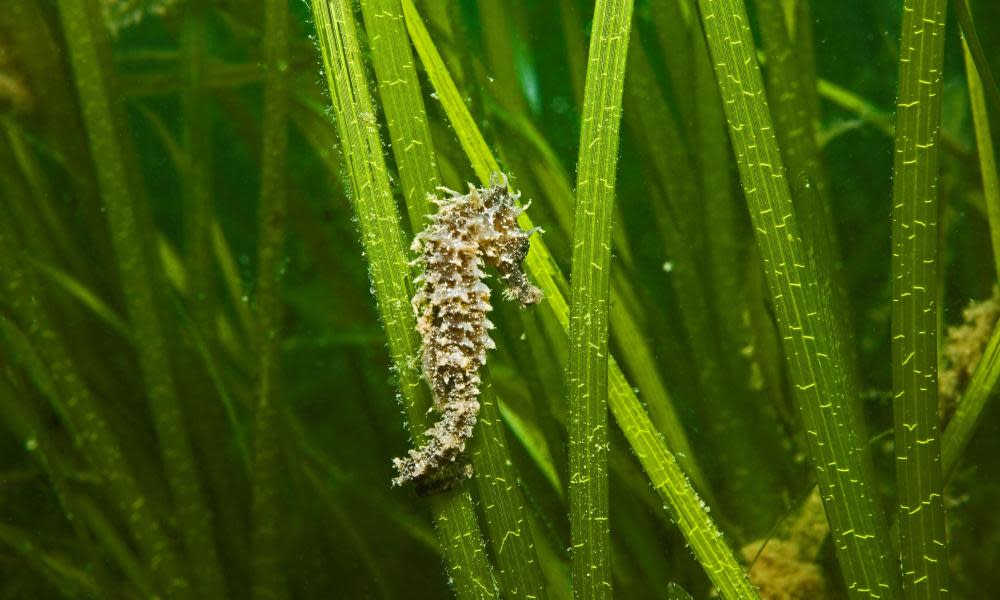Marine heatwave set off 'carbon bomb' in world's largest seagrass meadow

A marine heatwave in Western Australia in 2010 set off a massive “carbon bomb”, damaging the world’s largest seagrass meadow, releasing millions of tonnes of carbon that had been collected for thousands of years below the surface.
Although Australia doesn’t currently count carbon released from damaged seagrass meadows in its official greenhouse gas emissions, if it did, the results mean those figures might need to be revised upwards by more than 20%.
Seagrass is a flowering grass-like plant that grows in shallow waters. It gathers carbon dissolved in the sea and buries it below the surface, often storing similar amounts of carbon in the top metre of sediment as is stored in tropical forests.
But unlike forests that store carbon for about 60 years before releasing much of it, seagrass meadows often store the carbon for thousands of years until they are disturbed. That process is thought to offset up to 2% of humanity’s greenhouse gas emissions.
Recent studies have shown that when the top layer of actively growing seagrass is disturbed – either by local impacts such as boat anchors or climatic impacts like heatwaves – the carbon that has been sequestered over thousands of years can be quickly released.
Since the start of the 20th century, seagrass meadows worldwide have declined at an average rate of 0.9% per year, mostly due to direct human impacts such as coastal development and water quality degradation. Over the last century about 29% of global seagrass has been destroyed and it is estimated it is releasing carbon at a rate similar to the emissions of Australia and the UK combined.
Oscar Serrano and colleagues from Edith Cowan University in Western Australia examined how much carbon was released when the world’s largest collection of seagrass meadows at Shark Bay were damaged by a marine heatwave in 2010 and 2011. Between 0.6% and 2.4% of the world’s seagrass coverage exists in that one location, where it has been growing for about 8,000 years.
“Despite seagrasses having thrived over millennia in Shark Bay, unprecedented widespread losses occurred in the austral summer of 2010/2011,” the authors wrote in their paper published in Nature Climate Change.
The stored carbon is released when the dead seagrass allows oxygen to penetrate the layers of dead seagrass, changing the bacteria that live in it. Estimates vary as to how much oxygen can penetrate the dead seagrass, and therefore how much carbon is released after a disturbance.
The researchers found 22% of the seagrass in Shark Bay was lost after the heatwave, compared with a 2002 baseline. Depending on how much oxygen that allowed to penetrate the layers of dead seagrass, the researchers found that caused the release of between 2m and 9m tonnes of carbon dioxide-equivalent, in just the three years following the heatwave.
They found that if the seagrass loss was counted in Australia’s national emissions accounting in that period, it would have boosted Australia’s emissions from land-use change by between 4% and 21%.
“It’s a carbon bomb,” said Gary Kendrick, a co-author on the paper from the University of Western Australia. “And it’s one that has gone off without documentation.
“If we’re not counting this carbon, then we’re underestimating our footprint.”
Since seagrass meadows can take decades to repair, the researchers said the damage from the heatwave could cause up to 21m tonnes of CO2 to be released over the following 40 years.
Serrano said the damaged seagrass has a double-whammy impact on emissions.
“So when you have an event such as the losses at Shark Bay, you not only lose the seagrass as a way of removing CO2, but the sequestered gas is released back into the atmosphere during seagrass matter decomposition,” said Serrano.
The researchers said local impacts such as inappropriate tourism and fishing could be managed to protect the loss of seagrass, but protecting them against climate change may require more radical interventions.
They suggested manually sowing seeds or transplanting seedlings as options that should be considered, since encouraging faster recovering would limit the amount of carbon lost after the disturbance.
They also said more controversial options – such as transplanting more resilient species not native to the area – might also need to be considered.

 Yahoo News
Yahoo News 
